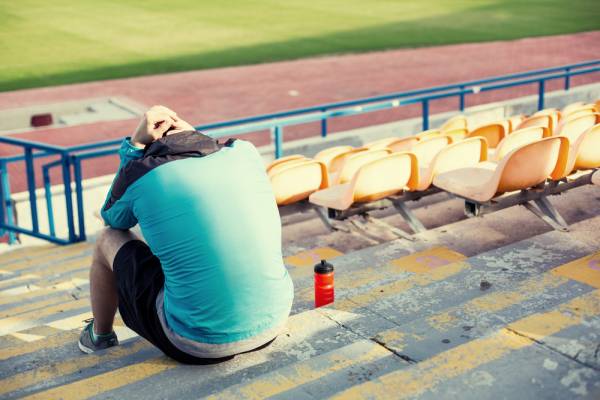Ten reps. That’s how many I demanded of myself on the fateful set of tire flips. By the fourth rep I was struggling, fatigued from previous sets, but I soldiered on – in retrospect, not the wisest decision.
The tire stood nearly vertical, and I grunted underneath it, straining to give it one last push. But I had little energy left, and within a split second, the 250-pound object toppled onto me, crushing me on the ground. My ankle twisted under the weight. Fortunately, a fellow gym member had been watching and swiftly lifted the tire. But the damage had already been done.
Shame, worry, and disappointment overwhelmed me as I lay on the ground clutching my ankle. But the most important question already swirling in my mind was, “How soon will my ankle heal?” I sensed the answer would not please me at all.
Bad Becomes Worse
The doctor and my parents predicted I would be up and running again within eight weeks at the most. Encouraged by the forecast, I listened only half-heartedly to their advice to avoid the gym. I continued to lift, first with the upper body but soon adding in lower body, thinking I was doing no harm.
But I was wrong. Eight weeks of recovery expanded into twelve weeks and, ignoring my protests, continued to grow. An MRI revealed tenosynovitis, a chronic ligament sprain, and bone bruising, none of which had been suspected at the initial diagnosis.
“An injury can illuminate your own character with a light that other situations cannot.”
The news deflated me like a hole in a balloon. I had been hobbling around for weeks on crutches, frustrated by pain and immobility. But after the MRI, it was clear I needed physical therapy. My busy schedule would be further compounded by the search for a good practitioner, frequent appointments, and long rehab routines to perform at home.
No one wants to have his or her performance hindered by something that could have been avoided, but I am now appreciative of the experience. An injury can illuminate your own character with a light that other situations cannot. How do you think of yourself? What are your priorities? Can you adapt your usual approach to fit your new status?
3 Steps to Make Lemonade From Lemons
These are three lessons that my ankle sprain have taught me, three aspects of reality that I would have had to face sooner or later. But if you can internalize these, you will be way ahead of the game if you ever do hurt yourself (hopefully you won’t!).
1. Don’t Fight Yourself
There is only one person in this world whose behavior you are in complete control of: yourself. Realize this power and take advantage of it to facilitate your recovery. Don’t let ego, impatience, or another irrational compulsion impede your own ability to help yourself. If you’re injured, your number one priority is to recover fully.
For the first two or three weeks after my injury, I (reluctantly) avoided full body workouts and focused on upper body. But the monotony irked me. I felt I was not working hard enough. This inner battle between discretion and emotion had poor results. Almost as soon as I could get off crutches and walk mostly without pain, I added squats, lunges, and a few other exercises back into my routine. “I’m not doing these with heavy weight,” I thought. “So they should be okay.” I was wrong. My ankle started swelling again, chastising me for being too bold and too hasty.
There’s no room for internal conflict when you are rehabbing. Make decisions that will provide tangible benefit to your body, rather than a temporary balm to your mind.

2. No, You’re Not Ready
Injuries, especially more serious ones, are fickle things. As long as you have plenty of rest, you will make good progress in the beginning. But this phenomenon is like that of a beginner’s gains: the first few weeks please you, but a dismal plateau soon sets in.
Be in tune with your body. When you feel you’re ready to return to your usual training (like I did), chances are you’re actually not. You need to regain coordination, stability, structural integrity, proprioception, and a host of other capabilities that have atrophied since you’ve lessened the load on the injured body part. The recovery of extremities, especially, seems to slow down maddeningly once they are about 80% healed.
“You need balance between intensity and ease, hope and realism, training and life.”
Do you think you could keep up with a posse of energetic four-year olds in a game of tag? You’d be running, leaping, swerving, reaching, ducking, grabbing, and tussling. When you can confidently answer “yes” to that question – and not before – return judiciously to your regularly scheduled programming.
3. Find Balance
People often give this advice for free, but obstacles actually impress it upon you. You need balance between intensity and ease, hope and realism, training and life. Lack of balance was what caused me to get injured in the first place. I pushed myself to finish a set under accumulated fatigue when it would have been wiser to back off and devote my competitive spirit to a less risky exercise.
There must be balance between different aspects of your training program, as well as between exercise and the rest of your life. The former safeguards you against injury by developing all of your physical qualities. The latter is necessary so you don’t develop unhealthy behaviors or commitments to one aspect above all else. Balance is a crucial contributor to keeping you healthy and expediting your return to health after illness or injury. Cultivate it, prioritize it, and embrace it.

Sacrifices and Gains
Over the course of seemingly countless weeks, my outlook and attitude have morphed. I‘ve been forced to confront my own thoughts and fears – some of which I knew had been lurking, some of which had been undermining me, but all of which I had not previously acknowledged.
At times, I felt like my prospects were bleak. The work of bouncing back from injury is harrowing and time-consuming enough, and on top of that we still have to deal with life. It also wasn’t easy to have to skip a Spartan Race and a kettlebell workshop, both of which I had been looking forward to. Even though these events were weeks after the injury, I didn’t have full function of my ankle, and exerting myself at either would only have set me back even further.
Coping becomes much easier, though, when you laugh and use challenges as opportunities for growth rather than buckle in the face of despair. Come to peace with your injury. Make it your teacher and guide, and you will emerge a stronger person.
More on injury and recovery:
- 7 Reasons Your Injury Is Not Getting Any Better
- You Don’t Need More Training, You Need More Recovery
- How Much Recovery Do You Need? 7 Factors to Add Up
- New On Breaking Muscle Today
Photos courtesy of Shutterstock.






